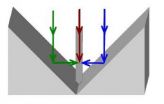Astronomers had thought that disk galaxies (like our own Milky Way) had largely finished forming by about 8 billion years ago, as indicated by the rates at which stars are formed in the Universe. Therefore, many astronomers have assumed that distant, much younger disk galaxies are not all that different from nearby ones.
The new observations, which discern the motions of the stars and gas inside the distant galaxies, prove that this long-held assumption is wrong. These new data reveal that the motions of gas and stars inside galaxies have been continuously settling down over the last 8 billion years while galaxies slowly assume the familiar flat disk shape of nearby galaxies. This surprising finding is announced in an article titled "The Epoch of Disk Settling: z ~ 1 to Now" by Dr. Susan A. Kassin and 13 collaborators, published in the October 20, 2012, issue of The Astrophysical Journal.
"Today, the majority of local galaxies forming stars are rotating disks, such as our Milky Way or M31 (the Andromeda Galaxy)," explained Kassin, a postdoctoral fellow at NASA's Goddard Space Flight Center in Greenbelt, MD. "Disk galaxies are well ordered: there is a defined plane to the galaxy and most stars and gas revolve in one direction around its center. Very few stars or clouds of gas have non-circular motions."
Many astronomers have long assumed that by an age of about 5 billion years, disk galaxies had come to look nearly the same as they appear today. "It's almost like a mantra," Kassin said. "Many astronomers say that the Hubble sequence is in place by a redshift (which astronomers denote with the letter z) of 1," using astronomical shorthand for two important concepts. The Hubble sequence is a diagram—originally devised by Edwin Hubble in 1926—for classifying the visible shapes of galaxies. Because looking far out into the depths of space is the equivalent of looking back in time to earlier eras in the universe, the redshift z is how astronomers measure both age and distance in the universe; a redshift of z = 1 corresponds to approximately 8 billion years ago, when the universe was only about 5 billion years old.
However, to the surprise of Kassin and her 13 coauthors, the observational evidence suggests something quite different. The internal motions of stars and gas within galaxies back in time are far more disordered, moving every which way rather than neatly revolving around the centers of galaxies. Moreover, they found that the Hubble sequence of well-ordered disk galaxies, used to describe galaxies today, gradually evolved from earlier more chaotic forms over the last 8 billion years. "It is clear the Hubble sequence was not in place at a redshift of 1," Kassin said.
One important key to the discovery was how the 14 collaborators—six from the University of California—selected the galaxies to study. "Sample selection can be quite insidious," co-author Benjamin Weiner of the University of Arizona explained. In past studies of galaxy evolution, researchers typically studied only those galaxies that are recognizably disk-shaped like most galaxies in today's universe, excluding any that are obviously disturbed. But such morphological (shape) criteria can bias the result. In contrast, "we included all galaxies bright enough to give spectra from which the motions inside galaxies could be measured," Weiner explained.
A second important key to the discovery was that past studies only examined the speed at which the stars go around the centers of galaxies. "In addition to rotation speed, we also measure the disordered motions in galaxies," Kassin explained. They did this by examining the galaxies' spectra. A galaxy's spectrum is the rainbow of colors produced when the light from a galaxy is dispersed by a prism or grating at the focus of a telescope; the spectrum may include bright lines at wavelengths where light is emitted and dark lines where light is absorbed. The presence, brightness, position, tilt, and shape of the bright emission lines in the rainbow spectrum yield key information about the motions of the gas inside a galaxy, as well as the galaxy's distance.
A third important key to the discovery was the large number of galaxies the coauthors studied, which yielded good statistical correlations. To test that they were observing what they thought they were, the collaborators performed mock observations on computer-simulated images of merging disk galaxies in various stages of disorder and at various distances. "We followed exactly the same procedures of spectral measurements as with observations of real galaxies," explained collaborator Joel Primack of the University of California, Santa Cruz . "This allowed us to measure the extent to which effects such as the observed sizes of galaxies and the blurring effects of the Earth's atmosphere play in the observations."
"We are learning that galaxies today are like young adults," said Kassin. "Many of them had exciting youths marked by intense interactions with other galaxies, with a lot of growth spurts in mass, new stars, and heavy elements. But that chaotic growth has been slowing down as galaxies mature, and they become more organized and calmer inside."
INFORMATION:
For more information:
Links to the paper in The Astrophysical Journal are http://iopscience.iop.org/0004-637X/758/2/106/ (as published) and http://arxiv.org/abs/1207.7072 (PDF of the full paper is at http://arxiv.org/pdf/1207.7072v1.pdf ).
The NASA Goddard press release "Astronomers Uncover a Surprising Trend in Galaxy Evolution," along with JPEG still images and videos, is at The NASA Goddard press release "Astronomers Uncover a Surprising Trend in Galaxy Evolution," along with JPEG still images and videos, is at http://www.nasa.gov/topics/universe/features/galaxy-evol.html and http://svs.gsfc.nasa.gov/goto?11087 .
For information on the University of California High-Performance AstroComputing Center (UC-HiPACC), visit: http://hipacc.ucsc.edu/
For interviews, contact:
Dr. Susan Kassin
Astrophysics Science Division
NASA/GSFC E313
Code 665, Laboratory for Observational Cosmology
Greenbelt, MD 20771
Ofc: 301 286-2054
Cell: 443 636-0293
susan.kassin@nasa.gov
http://www.susankassin.com/Susan_Kassin/Home.html
Dr. Benjamin Weiner
Steward Observatory, Department of Astronomy
University of Arizona
933 N. Cherry St.
Tucson, AZ 85721
520 621-4119
bjw@as.arizona.edu
http://mingus.as.arizona.edu/~bjw/
Prof. Joel R. Primack
Director, UC-HIPACC
Department of Physics
University of California, Santa Cruz
Santa Cruz, CA 95064
Cell: 831 345-8960
joel@ucsc.edu
http://scipp.ucsc.edu/personnel/profiles/primack.html
Press release written by:
Trudy E. Bell, M.A.
Senior Writer, UC-HiPACC
t.e.bell@ieee.org or tebell@ucsc.edu
http://trudyebell.com/
END


